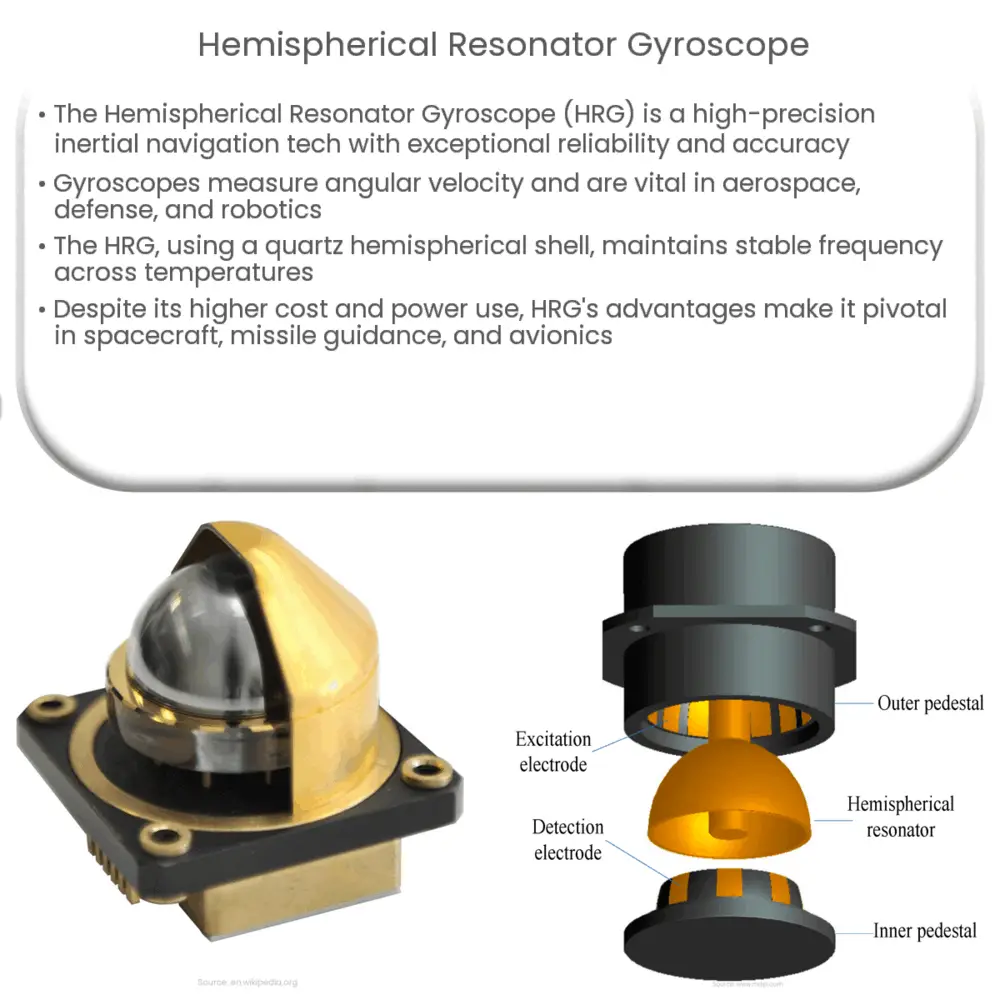The Hemispherical Resonator Gyroscope is a high-precision, reliable device for measuring rotation in spacecraft, missiles, and avionics systems.

Hemispherical Resonator Gyroscope: An In-Depth Look
Introduction
The Hemispherical Resonator Gyroscope (HRG) is a high-precision inertial navigation technology used for sensing rotation in various applications, from spacecraft to guided missiles. Its primary advantage over other gyroscopic technologies is its exceptional reliability, longevity, and accuracy. This article delves into the inner workings, applications, and advantages of the HRG.
Understanding Gyroscopes
Gyroscopes are devices that measure angular velocity, allowing for precise determination of orientation and rotation in a variety of systems. They are used in navigation, stabilization, and control systems across many industries, including aerospace, defense, and robotics. There are several types of gyroscopes, each with its unique characteristics, such as mechanical, optical, and MEMS-based gyroscopes.
How the Hemispherical Resonator Gyroscope Works
The HRG is a type of Coriolis vibratory gyroscope that uses a hemispherical shell as its resonating element. The hemispherical shell is made from a high-quality quartz material and is mounted on a base, typically made of metal or ceramic. The shell is set into motion by an electrostatic force, causing it to vibrate at its natural resonant frequency. When the HRG experiences rotation, the Coriolis effect causes a secondary vibration orthogonal to the primary vibration. This secondary vibration is proportional to the angular rate of rotation and is detected by capacitive sensors mounted on the base.
One of the key features of the HRG is its ability to maintain a stable resonant frequency over a wide temperature range. This is achieved by using a temperature-compensated oscillator circuit that adjusts the electrostatic driving force to maintain the desired resonant frequency. The quartz material’s low thermal expansion coefficient, combined with the hemispherical shape’s inherent mechanical stability, allows for excellent frequency stability and, consequently, high accuracy in measuring angular rates.
Applications of Hemispherical Resonator Gyroscopes
Due to their superior performance, HRGs have found widespread use in demanding applications requiring high precision and long-term reliability. Some of these applications include:
- Spacecraft Navigation: HRGs are used in satellites and other spacecraft for attitude control and navigation, providing accurate and stable orientation information for long-duration missions.
- Missile Guidance: The high accuracy and reliability of HRGs make them suitable for use in guided missile systems, ensuring accurate target tracking and navigation.
- Avionics: Commercial and military aircraft use HRGs for navigation and flight control, providing essential data for autopilot systems and aiding in maintaining stable flight.
Advantages of Hemispherical Resonator Gyroscopes
The HRG offers numerous advantages over other gyroscopic technologies, making it the preferred choice for high-precision applications:
- Reliability: HRGs are known for their long operational lifetimes and low failure rates, often exceeding 1 million hours of continuous operation. The absence of mechanical bearings and the use of high-quality materials contribute to their exceptional reliability.
- Accuracy: The temperature-compensated oscillator circuit and the inherent mechanical stability of the hemispherical design result in high accuracy and low drift, making HRGs well-suited for precise angular rate measurements.
- Compactness and Lightweight: HRGs are often smaller and lighter than other types of gyroscopes, making them ideal for space-constrained applications and reducing overall system weight.
- Resistance to Environmental Factors: The HRG’s design and materials make it resistant to shock, vibration, and temperature variations, ensuring consistent performance in harsh environments.
Challenges and Limitations
While HRGs offer many advantages, they also have some challenges and limitations:
- Cost: Due to the high-quality materials and specialized manufacturing processes, HRGs can be more expensive than other gyroscopic technologies, such as MEMS-based gyroscopes.
- Power Consumption: HRGs typically require higher power consumption than some competing technologies, which may be a concern for battery-powered or energy-constrained applications.
Conclusion
The Hemispherical Resonator Gyroscope has emerged as a leading technology in the field of inertial navigation due to its exceptional reliability, accuracy, and performance in challenging environments. While the cost and power consumption may be higher than some competing technologies, the HRG’s advantages make it a compelling choice for critical applications in spacecraft navigation, missile guidance, and avionics systems. As technology continues to advance, it is expected that HRGs will play an increasingly important role in the field of inertial navigation and guidance.

